|
|
|
|||
|
|
||||
|
|
||||
| Smoke Trails | ||||
|
|
HOME | SITE MAP | FORUM | CONTACT |
|
||
|
ABOUT | MOTORS | MODELS | ARCHIVE | HISTORY | STORE | FAQ | LINKS
|
|
|
|
|
|
||||||||||||||||||||||||||||||||||||||||||||||||||||||||||||||||||||||||||||||||||||||||||||||||||||||||||||||||||||||||||
|
Smoke Trails 19
(December 2008)
by Roger Simmonds Adapted from a column originally published in SAM 35 Speaks, December 2008  My header illustration appears on the box of a recently acquired late model Jetex 50C. I hadn't seen this drawing before: its relative crudeness is an indication, perhaps, of how the situation at Jetex had deteriorated towards the end. Not only is the draughtsmanship rudimentary, even a casual glance shows that the aeroplane would be very unstable – where is the tailplane? Or had some prescient illustrator anticipated the X-45, which can only be kept in the air by computer control? |
|
||||||||||||||||||||||||||||||||||||||||||||||||||||||||||||||||||||||||||||||||||||||||||||||||||||||||||||||||||||||||||
|
|
|
|||
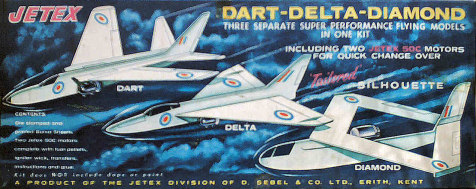 |
|
|||
|
In contrast, the artwork of this recently unearthed Dart-Delta-Diamond kit is a at least a professional job – bright blue with silver models and a red Jetex logo picked out in white. But yellow, long characteristic of the Jetex brand, is seen only, and incidentally, in the models' names. I had been after this kit for some time as it was the last in the line of the ‘Tailored Silhouette' models, and I wanted to trace the parts and recreate the models. I must therefore thank Andy Blackwell and Bert Judge for unearthing this one. I will discuss the kit contents later. Whilst we are on the subject of box top art, below is a nice example of the M.7 Flying Boat from Mike Ingram's extensive archive: |
 |
|||
 An actual example of this kit is proving even more elusive than the Dart-Delta-Diamond, and despite pleas in SAM Speaks and on the internet, I've yet to get my hands on one. It's a pity I didn't ask Bert Judge when Andy Blackwell and I visited him recently. Bert is, I am delighted to say, still fit and well, and as kindly and sharp-witted as ever. What made our visit even better was that we were able to meet up with Brian Riddell, the designer of the Delta and co-designer of the Diamond. Brian was then a very junior employee at Sebel/Jetex in the early sixties, and worked with Bert and Joe Mansour. He has a number of stories and pertinent observations of his times there that either he or I will share with readers in due course – for example his struggles with an all plastic foam glider, and why Joe Mansour never got into radio control commercially. |
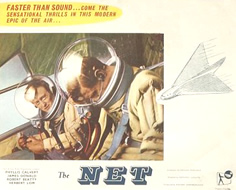 |
|||
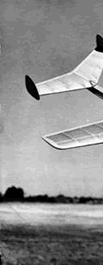
Jetex Flying in Finland I have had some interesting correspondence with Goran Brunn, who flew real jets in the Finnish Air Force for a living. Goran writes in his excellent English: “After the war people were not so wealthy as today and it was hard to get balsa and other model stuff. Jetex motors were not so easily available as in other countries, and Finland's Grand Old Man in Modelling, Olavi Lumes, told me that the Jetex system was too expensive to become popular. So ‘jet modelling’ never broke through, and it was only on the Finnish West coast that some modellers flew Jetex models. My friend in Vaasa had some Jetex models during the late 50s and early 60s. He flew a Fouga Cyklon modified with homemade wings as the original ones were not good. He also tried the Jetex on a normal glider. It took off but did not climb almost at all. He was also in the local shop many times like me looking at the Gnat kit but it was too expensive.” Presumably this was the Tailored model, its attractiveness enhanced by the fact that the Finnish Air Force was flying Gnats at that time. [Goran continues] “One of my other friends built the ‘Lill-Draken 210’ from a [Sigurd Isacson?] kit. He told me that it flew very well. This was about 1956. He and his friends also built their own constructions for the Jetex. They bought the Jetex engines and fuel pellets from Sweden. Another friend, Kaj Granström, and his brother, tried to buy a Jetex engine and a model (Super Sabre?) in Helsinki but had to order them via air mail from Sweden. So my conclusion is that only on the Finnish West coast were these engines available, towns like Kokkola, Vaasa and Turku. This may also interest you: when I and my father visited the Beograd Aviation Museum in Yugoslavia in the early nineties I bought a rocket plane, the ‘Raketoplan Pionir’' and a few rocket engines from the museum shop. I have not yet built it but everything is intact in the box:” |
|
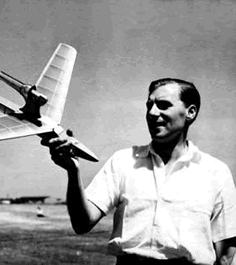
- Tim Westcott
|
||
 Many thanks, Goran. We had previously known little about model jets in any Nordic country except Sweden, and, to my shame, I had never heard of Olavi Lumes. I wonder if Jetex, or copies thereof, were available in the USSR. The Pionir's motor is bigger than a Rapier, and the specification (2.5 N for a few seconds) confirms my suspicions that the Pionir is a rocket-boost glider: not quite what we are supposed to be about in these articles – unless they are Jetex powered, of course. The Jetex Wren It has long been my desire to recreate some of the early Jetex Silhouette designs. These ARTF kits included ‘scale' models like the Javelin and Swift; the aforementioned M7 Flying boat, and, most desirable of all, the Sharky and Wren. This is a good time to publish these photos of a genuine Wren from Mike Ingram's archive. |
|
|||
 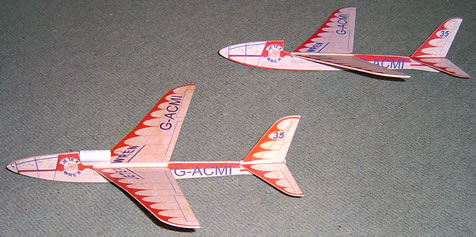 I have now made five ersatz Wrens at 95% of the original size, printing Howard's template on to tissue or iron-on transfer paper (IOTP) using an ordinary ink-jet printer, and transferring these to light balsa. The tissue was doped on, though spray-on adhesive would have perhaps been better, as some leaching of colour (red, in particular) occured. All models, whether tissue covered or ‘ironed on’ were 9-11g with motor mounts, so there is little or no weight penalty using IOTP. However, with the best IOTPs costing up to £1.50 each, this technique is much more expensive. It is also tricky for modellers unused to pressing shirts or covering their models with nasty plastic film. Both Howard's and my examples had Now a Rapier L-1 with 80mN behind its nozzle is approaching an Atom 35 (quoted as |
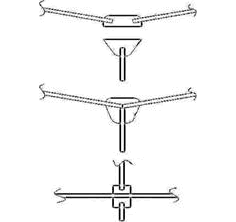 The motor, wick, etc. were all included and it really did fly straight out of the pack. As reported in (Jet)X Files 12 (Dec. 2003), David Carpenter traced an original Wren, from which Howard Metcalfe created a beautiful 3-view (below, and see Smoky Addiction 11 (Nov. 2005). Howard has now refined this drawing further and made this fine example left for Rapier L-1 power. 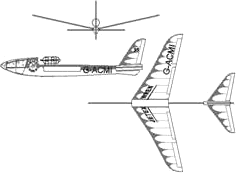 |
|||
|
Accordingly, a mounting bracket was screwed in place, an Atom 35 loaded up (curious how, like riding a bike one doesn't forget how to do this) the fuse lit, wait … fizz … launch. The result is shown right. Despite the 2-3g weight penalty (an L-1 weighs 4.9g, a loaded Atom 35 7g) the flight pattern was at least equivalent to a good 65 mN. The ICI pellet burned for about 10 sec. We then tried a Sebel pellet: this burned fiercely, giving quite a bit more thrust and a very sprightly climb. But only for seven seconds. A miserably short duration always was a problem with the Atom 35. The glide was a bit faster. So the recreation of the Wren has been a most satisfying experience, and, in order to share the Wren magic, it is hoped Bluebottle will be produce a kit. This would contain all parts laser cut to shape and pre-printed coloured tissue, as IOTP, would make any product much too expensive, and as I implied earlier, ironing on to balsa, even for single parent experienced in laundering, is a somewhat fraught procedure. |
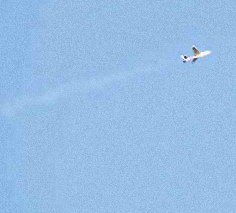
- Roger Simmonds
|
|||
I have every hope my Sharky for L-2/50C will go as well as the Wren. I then hope to have a go at the Dart-Delta-Diamond models, beginning with the Delta: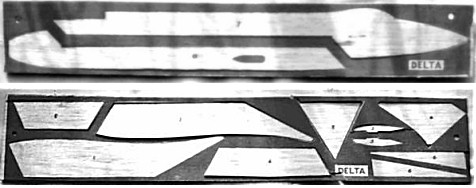 All parts are die cut (quite poorly in this example); for some reason, waste wood was stained bright red. Full instructions are printed on the back of the box; above right is how the Delta goes together. As can be seen, this is a bit of a jigsaw and not half as ‘ARTF’ as the Wren, but it is logical and ensures a warp free structure. Note the clever use of glued-in incidence templates. The instructions advise a coat of clear dope and sparing use of silver. Two large and very attractive sheets of transfers are included in the kit. These roundels, flashes and registration numbers, are typical of an RAF jet fighter of the period. And would have done wonders for the looks of the models. |
 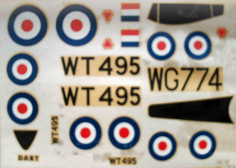 |
|||
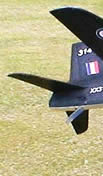
Jetex, and FROG before them, well understood the importance of an attractive colour scheme for their products, and the Delta Dart-Diamonds were, and I hope, will be, eye catching models. The only compromise to Rapier power will be to put the motor on a ‘weapons pod’ below the fuselage, well away from any balsa surfaces. I'm undecided whether to build them at their original size or reduced for the smaller, cheaper, and (let's face it) more reliable L-1. Brian Riddell and Memories of the Latter Days at Jetex |
|
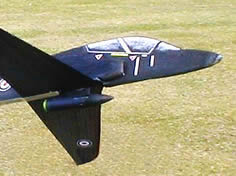
- Howard Metcalfe, retouched JMC
|
||
|
Discussion of the DDD brings us neatly back to Brian Riddell (right), who as a model maker, age 16, and fresh out of school, played quite a part in their development and testing. Brian writes: “The project that I had the most input was what became the 3D jet kits, a simple idea to incorporate three high performance models in one box. The name came from the planforms of the jets. It was a joint design: Bert did the Dart, Joe Mansour the Diamond, and I did the Delta, which at the time wasn't on the other's wish list. The Diamond was a terrible idea – just a whim really – and despite sticking to the plans, it just didn't want fly. “I had to persuade everybody that it had it to have an angle built into the front and rear wings (incidence). After a lot of experimenting it flew in a fashion. The Dart was more conventional and flew straight off the board; the Delta was a larger version of a catapult glider that I worked on before I started at Jetex. Incidentally, this [smaller] one eventually became ‘giveaway’ in a packet of cereal [not, I think,my favorite ‘Shreddies’, as I would have got one!]. Mr Mansour was, I think, a bit sceptical about my powered delta so most of the original concept was done out of sight – he was a stickler for getting things right and could tear me off a strip if I slacked on a job. “The highlight was when all we gathered at Dartford Heath for the proving flights. All three of us were present for a change – Joe rarely came out on a test at that time. Both the Diamond and Dart flew quite well, but the Delta climbed away into the blue and nearly went out of sight – an instant hit with Joe and accepted by all.” Brian also worked on a stillborn successor to the Jetnik, “The original was band launched and the second stage was Jetex powered [a 50R]; the new idea was to power the rocket from the ground by motor and use a bi-metal strip to eject the parachute at the end of the motor run. We had some real success testing it on the marshes in lower Belvedere but the project didn't seem to go much beyond that.” It will be remembered that Joe Mansour was at that time trying to develop new fuel formulations that produced copious amounts of steam to boost the thrust. It would appear that Brian, against all modern (and thrice accursed) H&S perceptions, was involved in this. He recalls: “Testing fuels was another chore [!], checking thrust and casing temperatures on a small test bench after preparing fuel pellets in a little outbuilding with a fly press. The fuel was very safe when compressed, but highly explosive in its raw state, especially in the form of a fine powder or dust. The fuel and wick were made and stored in the wick building, which was located by the entrance gate well away from the main building. You had to be careful in there for obvious reasons. I can only remember one accident, caused by an operative who mixed up wick powder incorrectly and to cover his tracks tried to dispose of it in the incinerator. The explosion badly burned him, damaged several cars and destroyed the incinerator! “I left Jetex with great regret, but I knew the end was in sight as the whole company seemed to be stuck in the past, much the same as a lot of British companies, and I had the chance of a five year apprenticeship.” |

- Brian Riddell
|
|||
|
Galas and Get-Togethers How gratifying to have seen some new rocketeers this year, and, given the generally poor weather, how fortunate we have been at Old Warden – only the SAM Gala was unflyable. Otherwise, sunshine, zephyr breezes, thermals, and, at Peterborough Flying aces, a flat calm. Bliss. … Andy won Flying Aces Jetex/Rapier scale after burning the midnight oil to replace his first Bell X-1E, so tragically ‘hedgehogged’ on the road outside Old Warden a couple of weeks before.  Above: Andy's second Bell X-1E , built from the Bluebottle kit – a very consistent performer with novel crash-proof slide-in wings. More photos next month! Finally, Jetex Jim, Rocky Rapier and his new trophy wife ‘Keilkraft Kath’ (right, and whether S.M.A.E. or ICI Trophy I neither know nor care) wish you all a very Reactionary Christmas. |
 Keilkraft Kath |
|||
|
|
||||
|
|
|
|||
|
|
|
|
|
|
|
|
Acknowledgements - Article: Roger Simmonds - Illustrations: Andy Blackwell, Goran Brunn, Mike Ingram, Howard Metcalfe, Brian Riddell, Roger Simmonds, Tim Westcott |
|
|
|
|
ABOUT | MOTORS | MODELS | ARCHIVE | HISTORY | STORE | FAQ | LINKS |
|
|
Terms of Use
|
Queries? Corrections? Additions?
Please
contact us.
|
|